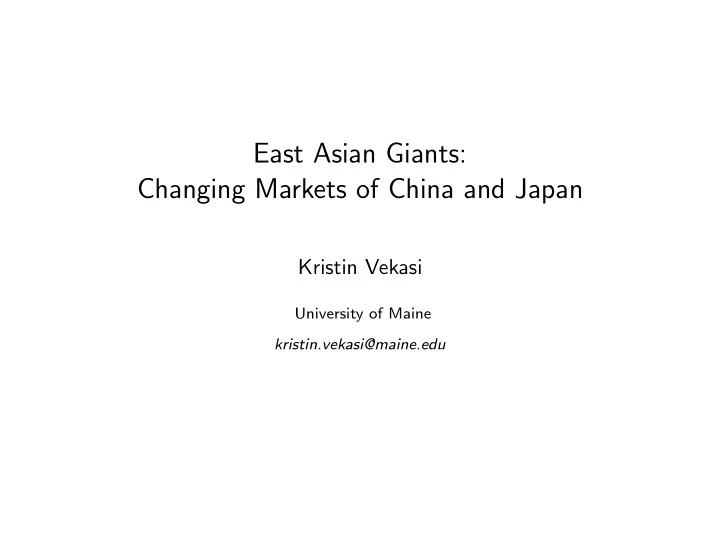

East Asian Giants: Changing Markets of China and Japan Kristin Vekasi University of Maine kristin.vekasi@maine.edu
The World’s Three Largest Economies 1200000 1000000 Actual Size of Economy Projected Size of Economy 800000 GNI in millions of USD 600000 400000 200000 0 Time
Prediction about the World’s Three Largest Economies (circa 1988) 1200000 1000000 United States Japan Germany 800000 GNI in millions of USD 600000 400000 200000 0 1960 1970 1980 1990 2000 2010
The World’s Four Largest Economies 1500000 United States Japan Germany China GNI in millions of USD 1000000 500000 0 1960 1970 1980 1990 2000 2010
China’s economy strong, US modest Most-strong growth in both economies Strong growth in both economies Modest-low growth in both economies Source: The Economist Dec. 27, 2011, “The Dating Game”
Japan China ◮ High-income, consolidated ◮ 35 years of economic democracy reforms and growth, though not for all Chinese ◮ Stagnant decades, but ◮ Multiple regional economies recent signs of growth with different market ◮ Competitive, but robust and potential stable consumer market ◮ Corrupt and capricious, but ◮ New market possibilities likely stable one-party with TPP authoritarian regime
“The Japan that Can Say NO” (1989)
Japanese Stock Market Annual Values, 1981-2015 40000 30000 Nikkei 300 Index 20000 10000 1980 1985 1990 1995 2000 2005 2010 2015
◮ “No economic recovery without structural reform” ◮ Privatization and administrative reform ◮ Bold domestic leadership Koizumi Junichiro Prime Minister 2001-2006
◮ Koizumi’s prot´ eg´ e ◮ Abenomics and the ‘Three Arrows’ 1. aggressive monetary policy: end deflation 2. expansionary fiscal policy: short-term economic boost 3. broad growth strategy Abe Shinzo Prime Minister 2007-2007; 2012-
◮ Reasons for optimism about recovery, US and Japan Per Capita Income, 1960-2013 Abenomics ◮ Japan is a 40000 Per Capita Income, 2005 USD stable, 30000 democratic, high-income 20000 country United States 10000 Japan 1960 1970 1980 1990 2000 2010 Source: World Bank Development Indicators
Points to watch: liberalization of agriculture, finance
US, Japan, and China Per Capita Income, 1960-2013 40000 United States Japan China Per Capita Income, 2005 USD 30000 20000 10000 0 1960 1970 1980 1990 2000 2010 Source: World Bank Development Indicators
Reform and Opening ◮ Late 1970s: special economic zones (SEZs) in Guangdong, Fujian ◮ 1980s: liberalization of exports ◮ Post-1986: coastal development strategy ◮ Rapid growth of export promotion trade ◮ Slow growth of ordinary trade ◮ Uneven regional composition of trade ◮ WTO membership in 2001: trade and inward FDI rocket
Special economic zones (SEZs) from 1980-2006: southern, coastal economic strategy Source: Wang, Jin, The economic impact of Special Economic Zones: Evidence from Chinese Municipalities, Journal of Development Economics , vol. 101 (2013):133-147.
Chinese Inward FDI, 1982-2013 Chinese Exports by Region China’s Balance of Payments, 1980-2013 3e+05 Balance of Payments, millions of USD 2e+05 1e+05 0e+00 1980 1985 1990 1995 2000 2005 2010 Source: World Bank Development Indicators
The China that Can Say ‘No’ (1996) and Unhappy China (2008)
Beijing’s Economic Model ◮ Export-led growth, employing vast, cheap labor force producing labor-intensive products ◮ High domestic savings rate ◮ Large state-owned enterprises account for 1 3 of total economic output, and maintain control of strategic sectors ◮ New shift: ◮ Domestic consumption ◮ Reform banking and state-owned enterprises
Trade as % of GDP in China, 1982-2013
M Schiavenza, “Mapping China’s Income Inequality” The Atlantic 9/13/13
M Schiavenza, “Mapping China’s Income Inequality” The Atlantic 9/13/13
M Schiavenza, “Mapping China’s Income Inequality” The Atlantic 9/13/13
Source: The Economist
More Developed China(s) Less Developed China(s) ◮ Demand for quality, foreign ◮ Manufacturing possibilities goods ◮ “Go West” campaign: ◮ Increasing consumption, Xi’an, Chengdu, Chongqing middle class ◮ Immense possibilities for ◮ New rich expansion ◮ Financial liberalization
East Asian Giants: Changing Markets of Japan and China Japan China ◮ High-income, consolidated ◮ Multiple regional economies democracy with different market ◮ Competitive, but robust and potential stable consumer market ◮ Relatively corrupt and ◮ New market possibilities capricious, but likely stable with TPP one-party authoritarian regime
Questions? Kristin Vekasi kristin.vekasi@maine.edu
Recommend
More recommend